1
What do I need to know how to do?
What Tools do I need?
First, verify that your components are tubeless compatible. See Tubeless Tire Compatibility for more information on tubeless tire standards.
3
There are two main methods for adding sealant to the tire:
This method requires a measuring cup. An air compressor is highly recommended.
This method requires a valve with a removable valve core, a syringe, and an air compressor.
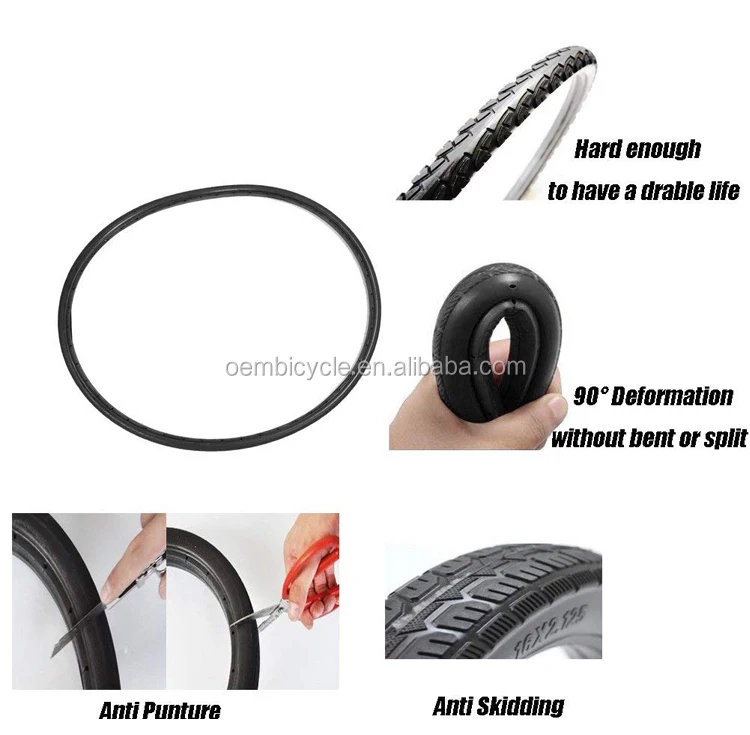
Sealant seeping through the tire bead
The rim strip on this wheel was not adequately sealed. Sealant may, in time, create a seal
4
In general, punctures in tubeless tires cannot be repaired. Punctures in UST tubeless tires, and other tubeless tires with a butyl inner lining, can potentially be repaired using a vulcanizing patch kit such as the VP-1.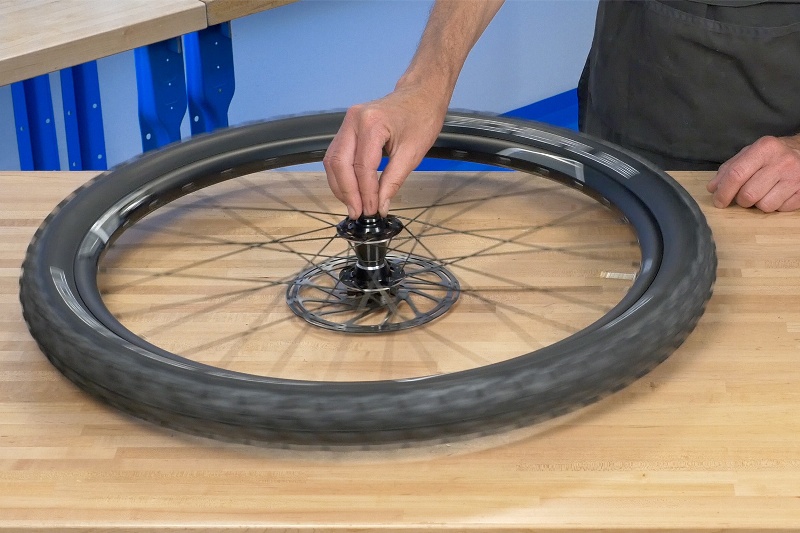 It is not recommended that you attempt to use other types of patches, or attempt to repair other types of tubeless tires.
It is not recommended that you attempt to use other types of patches, or attempt to repair other types of tubeless tires.
See Inner Tube Repair for instructions on using a vulcanizing patch kit.
Outside's long reads email newsletter features our strongest writing, most ambitious reporting, and award-winning storytelling about the outdoors. Sign up today.
You’re railing that descent, nailing every line and feeling like a world champ, when suddenly you smash a wheel into a big square-edge rock. Quite literally, you can feel the air go out of the ride. Not much kills the stoke from a great spin quicker than a flat tire. This is why tubeless tires are increasingly popular for all kinds of cycling. These setups use a liquid sealant instead of an inner tube to hold air. As a result, they offer better protection against all kinds of flats and enable you to run lower pressures than tube-type systems, increasing traction and creating a more comfortable ride. In the event you do get a puncture, tubeless tires are also more likely to stay attached to the rim, which is safer.
In the event you do get a puncture, tubeless tires are also more likely to stay attached to the rim, which is safer.
But ask most riders about going tubeless and you’ll encounter a litany of horror stories about setup. Why are some tubeless installs easy and others a multi-hour thrash session punctuated by merchant-marine levels of cursing? In short: manufacturing standards and tolerances. Wheels and tires from different brands vary ever so slightly in actual size, so a tire that fits great on one wheel is an overly tight nightmare on another. The good news is that this is slowly improving. Because manufacturing standards are getting better, with stricter tolerances, it’s now much more likely than even five years ago that you’ll be able to install and seat tubeless tires on the first try with a standard floor pump. Here’s a step-by-step guide.
 You’ll see people using all manner of cheap DIY approaches (Gorilla Tape is popular), but we recommend using actual tubeless rim tape. It’s not that expensive, and it’s far better suited to the task.
You’ll see people using all manner of cheap DIY approaches (Gorilla Tape is popular), but we recommend using actual tubeless rim tape. It’s not that expensive, and it’s far better suited to the task.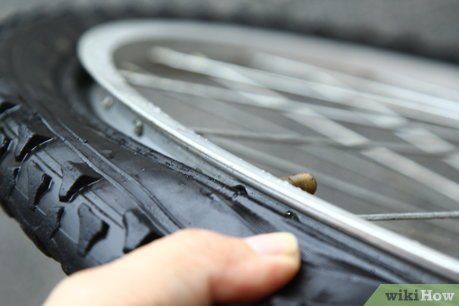
You’ll need tubeless-compatible or tubeless-ready wheels to start. This is governed by the rim profile itself (see the glossary, above). Most gravel and mountain-bike wheels these days are compatible; road bikes are not always so. But in any case, check manufacturer specs.
Most gravel and mountain-bike wheels these days are compatible; road bikes are not always so. But in any case, check manufacturer specs.
A warning: Do not under any circumstances try to make a wheel that is not listed as tubeless compatible into a tubeless system. If you’re lucky, all that will happen is the tire will blow off the rim in your garage and spray sealant everywhere. If you’re not lucky, the tire will hold just long enough for you to go on a ride, and then it will blow off, likely causing a crash. The same goes for tires: the bead on non-tubeless-ready tires will not hold securely in the bead lock and can blow off without warning.
Many higher-end wheelsets are tubeless ready right out of the box. For others listed as tubeless compatible, you’ll need to seal the rim bed (namely the spoke holes) with airtight tape. Good brands are Silca, Stan’s NoTubes, and WTB. You’ll need to match the tape width to your rim width.
This special elixir typically features very small solid particles of rubber or latex in a liquid suspension. When you’re riding, the particles slosh around the inside of the tire, where they find and plug small leaks. Good bets are Muc-Off, Orange Seal, and Stan’s. Buy an 8-to-16-ounce bottle. Sealant doesn’t dry out in the bottle over time like it does in tires, and you may want some extra in case the initial installation doesn’t go smoothly. Some bottles of sealant come with a measuring cup; if yours doesn’t, you’ll need a cup that has measurement markings in ounces.
Tubeless tires use special valve stems that create an airtight seal on the inside of the rim bed to prevent air loss. The rubber grommet that forms the seal sometimes has to be matched to the profile of your wheel’s rim bed (so-called universal valves claim to work with almost any system). The best valves have removable cores. Industry Nine, Muc-Off, and Stan’s make good universal valves with removable cores.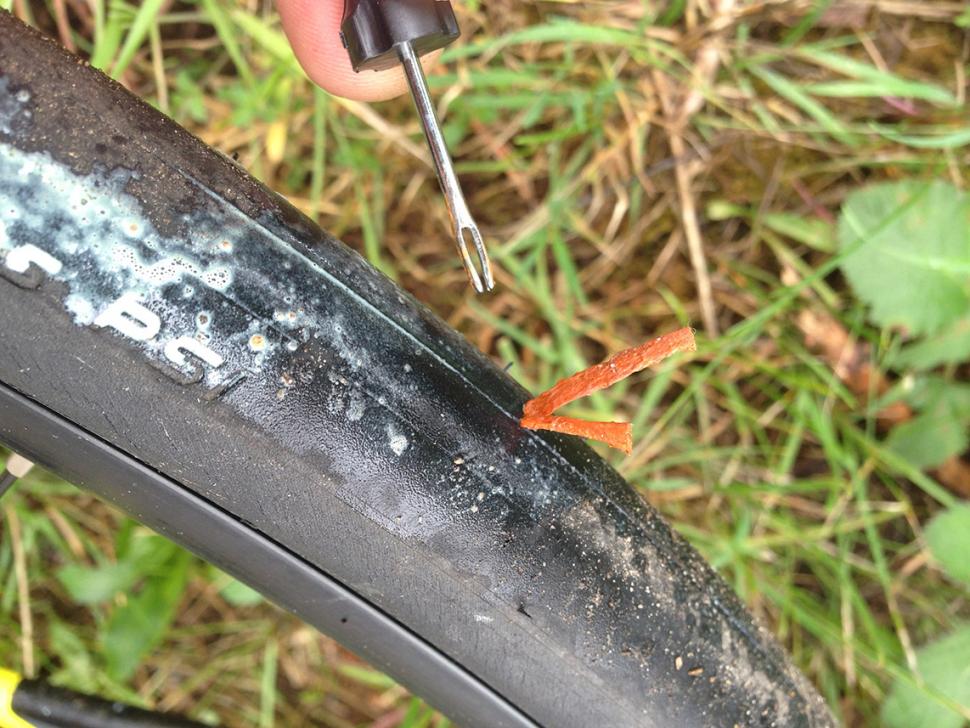
The sealant’s job is to plug holes, but it won’t seal a non-tubeless tire. More important: non-tubeless tires don’t have the specially shaped bead to lock to the rim. We’ll steer clear of recommendations here. Tires are personal and, for gravel and mountain-bike riding especially, the best choices are highly geography- and conditions-specific. Ask around for what others in your area use and trust.
You’ll need a floor pump, sturdy plastic tire levers, a valve-core remover (a very small and inexpensive wrench), a clean rag, a small paintbrush, some rubbing alcohol, and an old cup for soapy water.
These are big syringe-like devices that install the sealant directly through the valve stem. They’re fairly affordable ($10 to $30) and long-lasting. They’re also easy to use and much less likely to spill than the simple plastic measuring cup that comes with most bottles of sealant. Some have a needlelike attachment that can also be used to pull sealant back out of tires—useful if you’re swapping tires or want to store a bike for winter without letting the sealant congeal.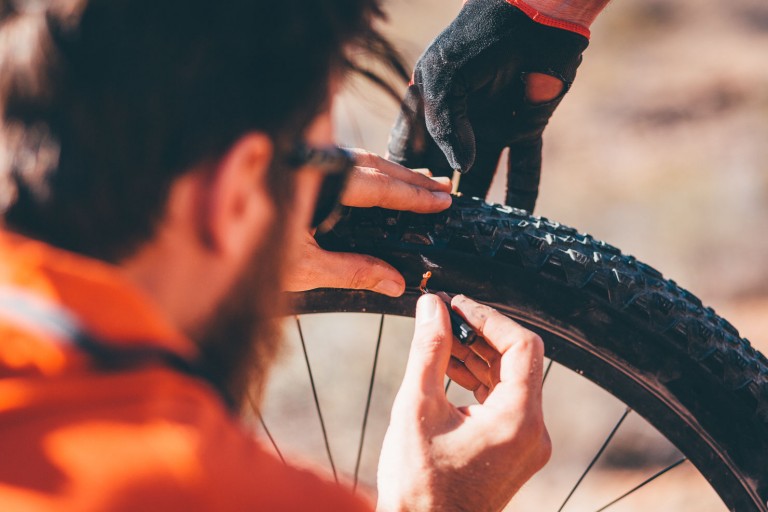 Stan’s makes a basic system, but I prefer the KOM or Mil-Kit versions (note: Mil-Kit’s system is more expensive but comes with universal valve stems).
Stan’s makes a basic system, but I prefer the KOM or Mil-Kit versions (note: Mil-Kit’s system is more expensive but comes with universal valve stems).
These are basically reusable air chambers that you pressurize with a floor pump, then place over the valve stem and use to inflate the tire quickly. They’re helpful because seating tubeless tire beads to the rim often requires a high volume of air delivered fast, and floor pumps can struggle to do that. Brands include Airshot, Mil-Kit, and Specialized. But these items are designed for one task only, which may not justify the price ($50 to $100) if you use them rarely. If you’re only installing tubeless tires on rare occasions, you can also use a conventional CO2 inflator system to seat beads. Many people use standard air compressors of the sort you need for home-improvement projects.
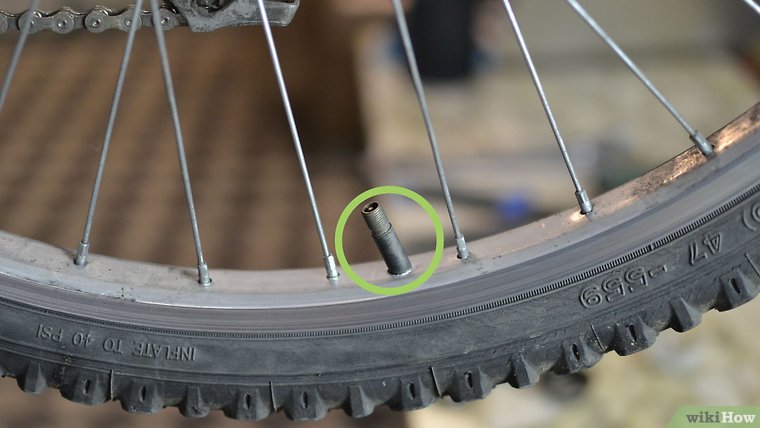 (Joe Lindsey)
(Joe Lindsey)Tools: Rag, rubbing alcohol
Whether you’re working with new wheels or ones you’re converting, make sure they’re clean. Dip a rag in rubbing alcohol, and thoroughly wipe down the rim bed, rim tape, and internal sidewalls. Pay special attention to removing any debris from the bead hook, where the tire will seat. Check to ensure that the tape is even and tight, with no wrinkles or gaps that could leak air. Wipe dry.
Tools: Tire lever, floor pump, tube
That’s right: use a tube first. Why? It’s an easy way to get at least one of the tire beads firmly seated to the bead lock and to work out the kinks in a tire bead after it’s sat folded in storage.
Unfold the new tire, and seat one side in the rim bed. Many tires, especially mountain-bike tires, are directional or even front- or rear-specific; check to make sure it’s in the proper orientation before installing.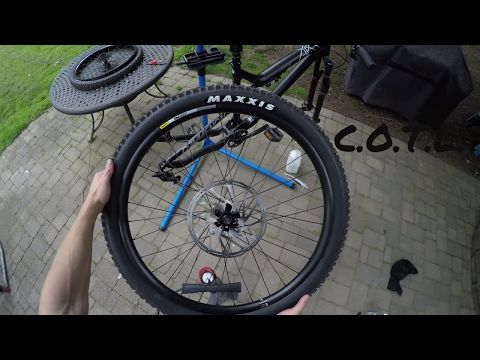 Tip: line up the center of the tire logo over the valve stem, as this can make it easier to find and fix leaks on rides.
Tip: line up the center of the tire logo over the valve stem, as this can make it easier to find and fix leaks on rides.
Inflate an inner tube just enough that it holds shape. Insert the valve in the rim’s valve hole, and tuck the tube into the tire. Finally, deflate the tube a bit, and install the other side of the tire. The bead will likely be tight in the last quarter or so. Use a tire lever, and carefully lift the bead into the rim well, taking care not to pinch the tube between the tire and rim. Once seated, push the tire bead toward the center of the rim bed, and visually check to make sure the tube isn’t pinched.
Inflate the tire, stopping at about 20 psi to make sure that the tire bead isn’t bulging out over the rim in any location. Resume pumping to a few psi short of the maximum inflation listed on the tire sidewall. You’ll hear some snaps and pops. This is normal; it’s the tire bead seating in the rim lock. Finally, set the wheel in a warm, sunny location for 15 to 20 minutes.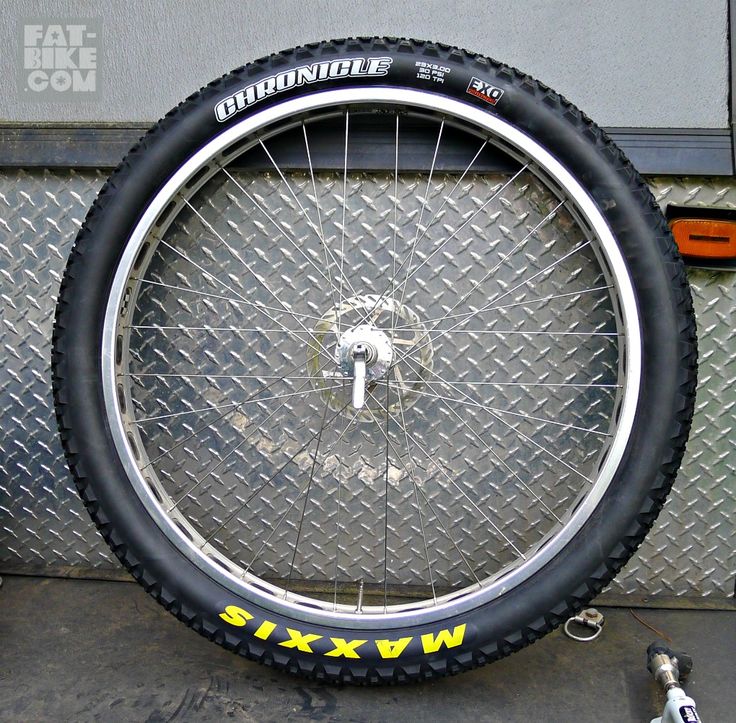 The heat softens the kinks in the tire bead, and—if you’re setting up wheels for tubeless for the first time—helps ensure that the rim tape’s adhesive is fully bonded to the rim and won’t leak.
The heat softens the kinks in the tire bead, and—if you’re setting up wheels for tubeless for the first time—helps ensure that the rim tape’s adhesive is fully bonded to the rim and won’t leak.
Tools: Tire lever
Take the wheel out of the sun, and let it cool back to room temperature. Deflate the tire. Carefully push only one side of the tire into the rim bed, then use the tire lever to lift that bead off the rim. Remove the tube, leaving the other tire bead seated in the rim.
Install the tubeless valve by threading the knurled nut as tightly as it’ll go with your fingers. Don’t use a wrench or pliers; overtightening could crack the rubber gasket on the valve stem and cause a leak. Make sure the valve you’re using fits the rim-bed profile (see “What to Buy,” above). A poor fit could leak.
Tools: Tire lever, tire sealant, measuring cup or injector, valve-core remover
If you’re using a sealant-injector system: Reinstall the loose tire bead, taking care not to dislodge the bead on the other side of the tire. Use the valve-core remover to unthread the core counterclockwise, then remove it and set it aside. Shake the sealant bottle for 10 to 20 seconds to thoroughly mix its contents, then measure out the appropriate amount for your tire size into the injector chamber:
Two ounces for road tires (up to about 28 millimeters)
Three ounces for 700c gravel or 27.5 mountain tires
Three to four ounces for most 29er mountain tires
Five to six ounces for plus-size mountain-bike tires
Seat the injector securely on the valve stem (or push the needle fitting through the valve stem), and then carefully inject the sealant into the tire. Reinstall the valve core.
Reinstall the valve core.
If you’re just using a sealant cup: Don’t worry about removing the valve core, since you’re not using it to add sealant. Reinstall the loose tire bead, but leave a final section unmounted. Prop up the wheel with this section closest to the ground but the opening tilted upward to prevent spillage. Shake the sealant bottle for 10 to 20 seconds to thoroughly mix its contents, then pour the appropriate amount into the cup, and carefully pour that directly into the tire at the unmounted section. Grab the wheel and gently rotate the unmounted section up to 12 o’clock, so that the sealant flows into a fully mounted section of the tire where it’s less likely to leak out, and wrestle the final section of tire bead onto the rim (you may need the tire lever).
Tools: Floor pump, soapy water, small paintbrush
Seating tubeless tires takes a lot of air rushing into the tire very fast to seat the tire bead into the rim lock. You might be able to do this with a floor pump, but you may need a higher-volume air source.
You might be able to do this with a floor pump, but you may need a higher-volume air source.
Take the paintbrush and dip it in the soapy water, then run it along the tire sidewall where the loose tire bead and rim bead lock meet. The soapy water helps the tire bead slip into place more easily.
If you’re using a floor pump: Because you’ve already seated one side of the bead, you may be able to inflate the tire with a floor pump. It takes some effort and maybe a little luck. First, thread the wheel skewer or axle through the hub—that provides something to grab as you spin the wheel to disperse sealant. Then firmly seat the pump chuck on the valve stem (making sure the stem core is fully open), and pump full strokes as fast as you can to get the installed but unseated tire bead into the rim’s bead lock. Again, you’ll hear those telltale snaps and pops. If you hear that, keep pumping! Pump to a few psi short of the maximum inflation listed on the tire sidewall.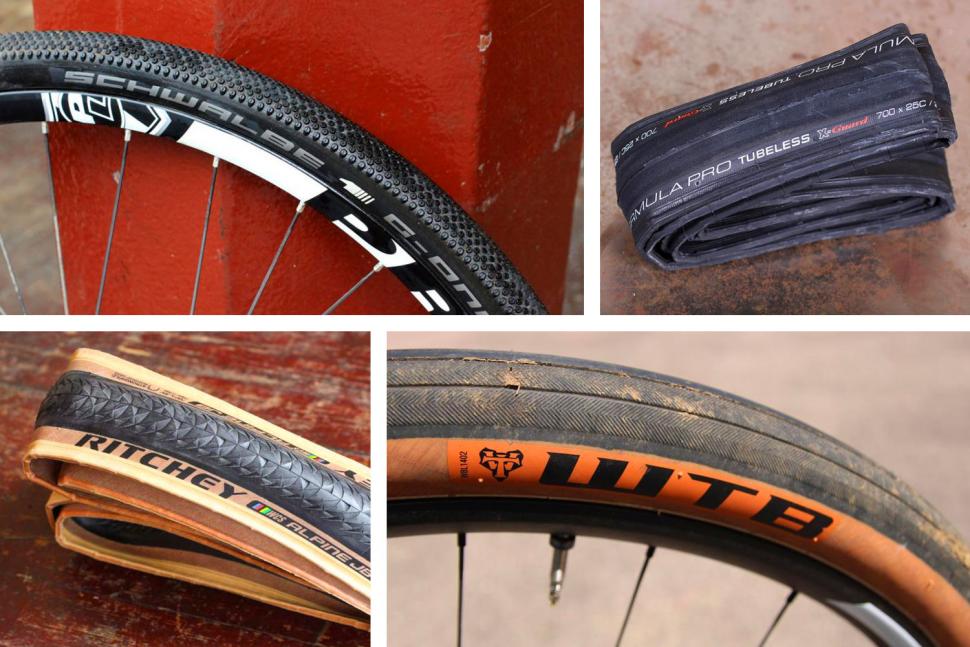 Quickly remove the pump chuck, grab the quick-release lever on the wheel skewer or axle, and spin the wheel for a minute or so, rotating the axis back and forth. This helps distribute the sealant evenly inside the tire. If you see sealant spraying out anywhere for more than a few seconds, stop; the tire’s not fully seated. Also: if you are pumping quickly for at least 30 seconds but the tire won’t hold any air, stop; the tire likely won’t seat with just a floor pump.
Quickly remove the pump chuck, grab the quick-release lever on the wheel skewer or axle, and spin the wheel for a minute or so, rotating the axis back and forth. This helps distribute the sealant evenly inside the tire. If you see sealant spraying out anywhere for more than a few seconds, stop; the tire’s not fully seated. Also: if you are pumping quickly for at least 30 seconds but the tire won’t hold any air, stop; the tire likely won’t seat with just a floor pump.
Secondary protocol: If you can’t get the tire bead to fully lock in the rim, you’ll need a higher volume of air delivered faster. This is where the CO2 cartridge inflator you normally use for trailside-flat repairs comes in or the special tubeless-inflation systems we mentioned above. Another option is a pump with integrated booster chambers, like the Bontrager TLR Flash Charger or the Topeak JoeBlow Booster, although these get mixed reviews.
In any case, the process is basically the same with a booster or combo pump: charge the booster chamber, securely fasten the inflator chuck around the valve stem, then release the air into the tire. If you’re using a CO2 inflator, use the largest cartridge you can find for mountain tires (up to 20 grams). If the CO2 cartridge successfully seats the bead, it may still not be at the full pressure needed to ensure a complete seal to the system. Remove the inflator, and switch to the floor pump, topping off the pressure to a little less than the listed maximum sidewall pressure.
If you’re using a CO2 inflator, use the largest cartridge you can find for mountain tires (up to 20 grams). If the CO2 cartridge successfully seats the bead, it may still not be at the full pressure needed to ensure a complete seal to the system. Remove the inflator, and switch to the floor pump, topping off the pressure to a little less than the listed maximum sidewall pressure.
Something to consider: stand-alone tubeless boosters cost $50 or more. Booster and pump combos cost $120. Pancake-style air compressors start at $99, plus $30 or so for a Presta attachment.
Whichever method you use, once the tire seats, grab the wheel by the quick-release or through-axle lever, and spin it to disperse the sealant inside. Success? Awesome. Check for obvious sealant leaks at the sidewall and valve stem. If you don’t see any, install the wheel on the bike, and ride slowly around the neighborhood—this helps the sealant foam and plug any microscopic hole in the system. Leave the tire inflated at the higher pressure, which helps ensure that the tire stays sealed.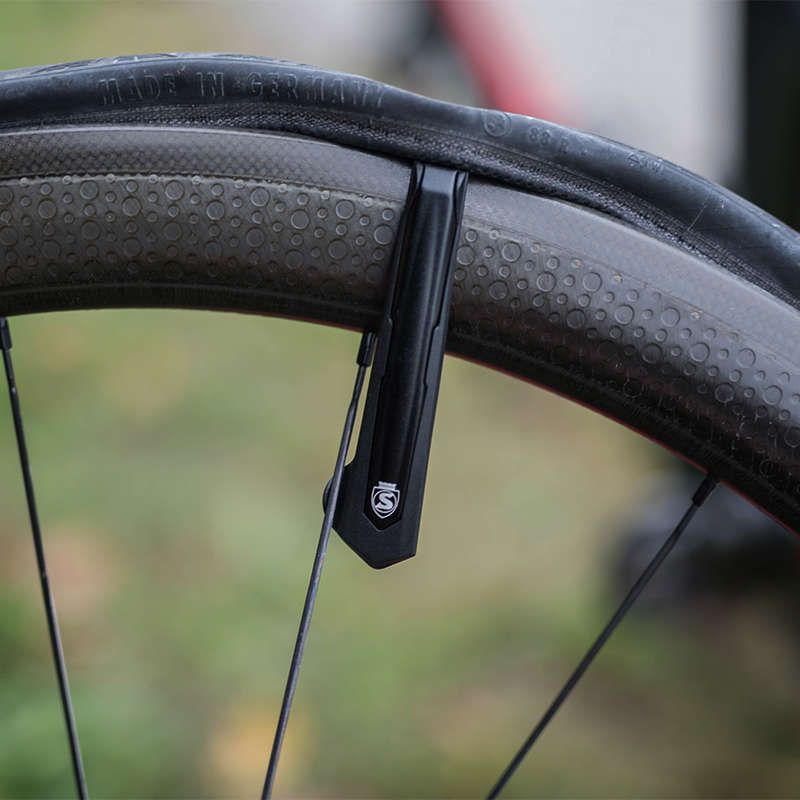
If this process didn’t work, the problem may not be something you can fix at home. In that case, we recommend going to a shop.
Many cyclists are used to the telltale hissing sound coming from tires. At any moment, your high-tech mountain bike can be put out of action by a simple thorn or a small piece of pebble.
Since the advent of pneumatic tires, this problem has haunted cyclists, tiring with the frequency of punctures and the amount of work needed to fix them. And only recently, bicycle tire and rim manufacturers have decided to create a universal tubeless system (UST).
This system is a sealed rim in which the holes for the spokes and the nipple are completely airtight. Also, the non-porous rim sidewalls have improved grip on tire walls that are thicker than conventional tires. During tire inflation, air presses the tire bead (lower edge of the sidewall) into the corresponding groove in the rim flange, thereby sealing the contact between the tire and the rim.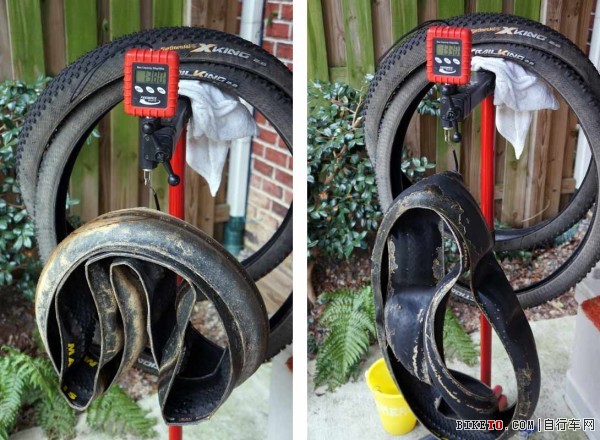
Theoretically, the advantages of a tubeless tire include low weight (due to the lack of a tube, although tubeless tires are heavier than conventional tires), less pressure (providing better grip) and the absence of pinch punctures (also known as "snake bites"). If you add some sealant to the system, penetrating punctures will also be a thing of the past.
But what about a cyclist with conventional rims without sealing? Just buy a conversion kit, tubeless or Tubeless Ready tires and he can send his bike tubes to the dustbin of history.
Of course, you can only add sealant to a conventional chamber. In this case, you won't gain any weight or grip advantage, just add a little weight to the wheels, but it will help you avoid punctures and not spend money on new tubeless tires and a tubeless conversion kit. Read our guide to using Gremetic in chambers.

Remove the wheels, tires and tubes from the bike. If the wheels are old, greasy and dirty, clean them with hot soapy water or alcohol. The rubber tape will need to be taped to the spoke bed of the rim, so the rim needs to be clean and free of dirt so that the tape is snug against it.
Take the rim tape and unfold it so that the nipple is on the inside of the tape. Run your fingers around its circumference and check it for cuts, nicks, bulges, and proper molding that could cause air to leak. Even if the tire drops a few psi in a day, it can be very annoying.
Position the part of the rim tape with the nipple in the spoke bed, gently push the end of the nipple through the hole provided for it and pull it out the other side. The piece of tape near the nipple is slightly thicker and therefore difficult to install correctly, but it is important to install it correctly now so that you do not have to look for the source of leaks later.
The piece of tape near the nipple is slightly thicker and therefore difficult to install correctly, but it is important to install it correctly now so that you do not have to look for the source of leaks later.
Next, you need to install the remaining section of the rim tape in the spoke bed. This is easier said than done as the tape is tight against the rim. The easiest way to install it is with a screwdriver with a long thin handle. Position the screwdriver perpendicular to the rim between the rim and the rim tape. Slowly moving the screwdriver around the circumference of the rim, set the rubber band evenly in the spoke bed.
First of all, make sure you have a working nipple that does not let air through. Most nipples have a special threaded lock washer that screws onto the nipple body. The nipple usually comes with a rubber o-ring that needs to be installed between the lock washer and the rim. By flattening the O-ring, you will create an additional seal on the outside of the hole.
Now that the rubber rim is in place and lying in the center of the rim, you need to check the uniformity of its tension throughout the entire length of the rim. Air can leak between the rim and the rim tape if there are loose or tight areas on the tape. Again go around the rim with a screwdriver and equalize the tension of the tape. This will take a few minutes.
Tires from different manufacturers or even different models from the same manufacturer differ in installation complexity, quality and other characteristics. If the tires were not installed on the wheel, then first install them as usual with tubes, inflate to the maximum recommended pressure and leave them overnight. After that, they will be much easier to install and pump.
Place the wheel on your feet so that the nipple is at the highest point of the wheel (at 12 o'clock). First, place the tire beads near the nipple, then walk with both hands around the circumference of the tire (in different directions), loosening the bead over the rim wall along the way. Once you get to the very bottom of the wheel, leave an 8-inch section.
First, place the tire beads near the nipple, then walk with both hands around the circumference of the tire (in different directions), loosening the bead over the rim wall along the way. Once you get to the very bottom of the wheel, leave an 8-inch section.
Some sealants can be applied without removing the nipple core, the spring-loaded piece that screws into the nipple body and allows air to enter the tire without escaping, but most cannot. Sludge Sealant can be injected without removing the core of the nipple. Removable core nipples are included in many conversion kits, but not all. The core must be unscrewed and removed. Be careful not to lose it as it can easily roll over furniture on the floor. If you have a nipple without a core to be removed, then immediately go to step 12.
Now that you have completely seated the tire on the rim and removed the core of the nipple, you can inject the required amount of sealant into the tire using the narrow line nozzle.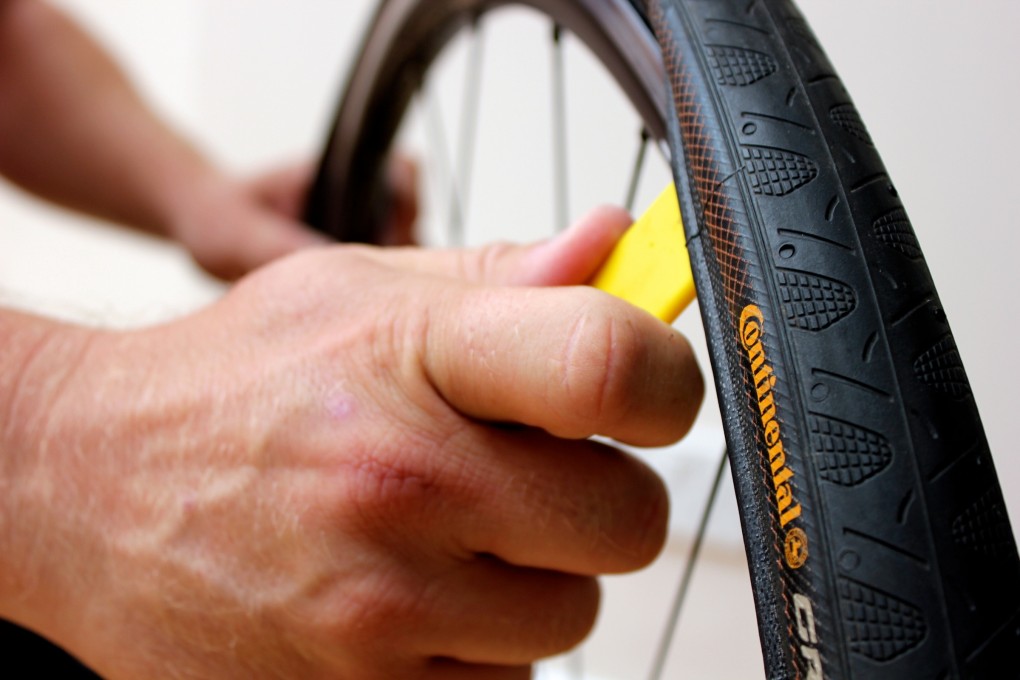 Shake the sealant bottle well before doing this.
Shake the sealant bottle well before doing this.
After the sealant has been poured through the nipple, screw the nipple core back. Before screwing in the core, it is recommended to lubricate its threads with petroleum jelly, which will reduce the likelihood of jamming of the core or difficulty in turning it.
If you don't want to or can't apply sealant through the nipple, leave a small section of the tire bead exposed on the rim and pour sealant through it. Use a bottle with a nozzle to infuse the sealant, as a natural rubber tire is difficult to keep its shape. Suspend the wheel carefully so as not to spill the sealant from the tire.
To install the last section of the tire, carefully rotate the wheel so that the uninstalled section is on top. Now you can let the sealant spread all over the tire. Do not worry if a little sealant still leaks.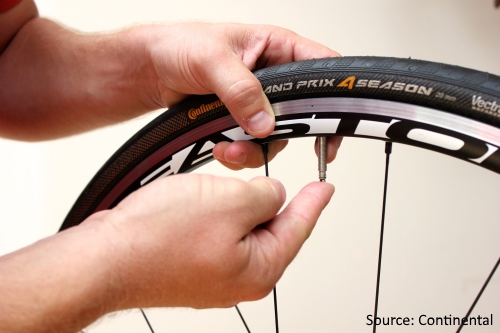
Start inflating the tires with the car pump until the tire beads press against the rim. When the pressure is too high (about 60 - 80 psi for UST tires and Tubeless Ready tires), the tire beads should click into place with a characteristic "clicking" sound. Be careful when handling this high pressure. Your tires are now tubeless.
Air can escape between the rim and tire. Raise the wheel, take it by the tire like you are holding a tray. Shake the wheel well so that the sealant spreads throughout the tire, reacts with the air and creates a thick sealing layer. Even if you skip this step, over time, the sealant will still spread on its own. Leave the wheel for 15 minutes, then repeat this step again. Air leakage should stop.
Hold the wheel up to your ears and listen carefully for air leaks. If a leak is found, then it is most likely a microscopic hole. Repeat step 15 and/or add more sealant.
The carcass of the UST tire is impregnated with special rubber to retain air. Tubeless Ready tires have thinner walls, which means they are lighter and less airtight.) They have a dockable bead needed to install them as tubeless. At the same time, Tubeless Ready tires can only be used as tubeless tires in conjunction with liquid sealant, but we still recommend buying UST tires. Theoretically, with the help of sealant, you can use both tubeless and conventional tires, but you can only install them correctly by trial and error.
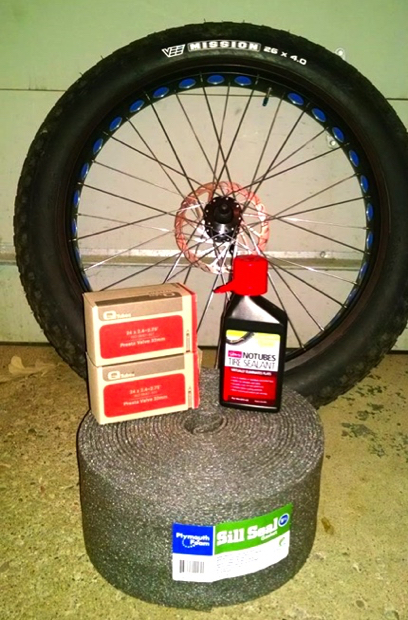 Inflate the tire to the recommended pressure.
Inflate the tire to the recommended pressure. In addition to the rim and TR tires, you will need:

First of all, you need to forget about the use of beads, as they can damage the tires. We do everything with our fingers.
1 All manipulations are carried out on an already assembled wheel. First we need to seal the rim. To begin with, we clean and degrease the rim. Since the holes for the nipples sometimes have burrs and can damage the yellow tape, we check the holes on the rim and grind the burrs with a file (most likely they will not be there). Then we wipe the rim over the entire diameter with a zero, degrease it with alcohol or another liquid and wipe it dry. Attach yellow tape. At the same time, we stretch the tape, we are not afraid to apply force, be sure to pass the central groove so that the tape fits into it. We start gluing 7 - 10 mm from the hole for the nipple with the expectation that it will be glued twice. We cut the tape and pierce the hole for the nipple with an awl. In order not to crush the seals, tighten the valve without using any tools. Then lubricate the rim from the inside and the heel of the tire from the outside with a special fluid designed for installing tubeless tires. Also, instead of this liquid, you can use a solution of water and soap. We cut the tape and pierce the hole for the nipple with an awl. In order not to crush the seals, tighten the valve without using any tools. Then lubricate the rim from the inside and the heel of the tire from the outside with a special fluid designed for installing tubeless tires. Also, instead of this liquid, you can use a solution of water and soap. | |
| 2, 3 - first place the first tire bead inside the rim, and then carefully the second bead. You have to work consistently and slowly. | |
| 4, 5 - after installing both beads into the rim, the tire is inserted entirely inside the rim and simultaneously straightened with a smooth circular motion of the hands. | |
6 Then we insert the tube, pull the tire onto the rim (it will be tight, it will fit both sides into the central groove on the rim, and the heel zones of the tire will be located close to the inner cavity of the rim).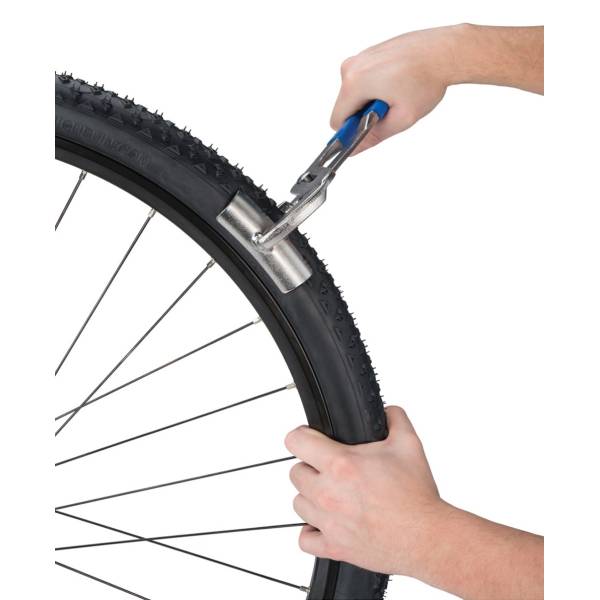 Loading up the camera. You can usually skip this step, but we need it in order to properly press the yellow tape to the rim with the camera and level it. In addition, we can see how the tire sits on the rim, which at the stage of installation with sealant will greatly simplify your life. As the tire sits tight, it may become crooked at first. That is, part of the bead cord of the tire will become as it should be under the bead of the rim, and the other part will remain in the central groove and, regardless of the force applied, it will not want to move into place. To correct this situation, we pump air to the pressure recommended by the manufacturer or a little more. It's different for every tire width. A loud sound will indicate that the tire bead has popped out of the center groove and snapped into place against the rim bead. If even now the tire has not become even, then you can help it to fall into place with your hands. If you want the labels on the tire to match the stickers on the rim, then pre-tighten the tire evenly, because after you have tensioned at least one side, it will be very, very difficult to dislodge the tire. Loading up the camera. You can usually skip this step, but we need it in order to properly press the yellow tape to the rim with the camera and level it. In addition, we can see how the tire sits on the rim, which at the stage of installation with sealant will greatly simplify your life. As the tire sits tight, it may become crooked at first. That is, part of the bead cord of the tire will become as it should be under the bead of the rim, and the other part will remain in the central groove and, regardless of the force applied, it will not want to move into place. To correct this situation, we pump air to the pressure recommended by the manufacturer or a little more. It's different for every tire width. A loud sound will indicate that the tire bead has popped out of the center groove and snapped into place against the rim bead. If even now the tire has not become even, then you can help it to fall into place with your hands. If you want the labels on the tire to match the stickers on the rim, then pre-tighten the tire evenly, because after you have tensioned at least one side, it will be very, very difficult to dislodge the tire. In this state, the wheel should be left for a day or several hours and you can start pouring tire sealant. We release air from the chamber. In the process of pressure drop, one or the beads may slip into the central groove. In the ideal case, one side remains in place, and we dismantle the slipped side. We take out the chamber, screw the nipple into place and fill in the sealant for tubeless tires. The amount of sealant depends on various conditions - I would recommend 100 grams. Before pouring the sealant, we board the tire about 3/4 of its circumference with the nipple up. It would be nice if someone could help you. One person holds the wheel and tire to keep the bead from slipping off the rim while a second person measures and pours the sealant. If you still have to work on your own, then it’s better to hang the wheel, because it’s wrong to pour sealant into a wheel that is on the ground with disassembled rubber. In order not to try to measure the sealant with the help of a container, we hang the jar of sealant on a conventional electronic kitchen scale, remember the weight and pour it until it comes out approximately 100 grams less when weighing again. In this state, the wheel should be left for a day or several hours and you can start pouring tire sealant. We release air from the chamber. In the process of pressure drop, one or the beads may slip into the central groove. In the ideal case, one side remains in place, and we dismantle the slipped side. We take out the chamber, screw the nipple into place and fill in the sealant for tubeless tires. The amount of sealant depends on various conditions - I would recommend 100 grams. Before pouring the sealant, we board the tire about 3/4 of its circumference with the nipple up. It would be nice if someone could help you. One person holds the wheel and tire to keep the bead from slipping off the rim while a second person measures and pours the sealant. If you still have to work on your own, then it’s better to hang the wheel, because it’s wrong to pour sealant into a wheel that is on the ground with disassembled rubber. In order not to try to measure the sealant with the help of a container, we hang the jar of sealant on a conventional electronic kitchen scale, remember the weight and pour it until it comes out approximately 100 grams less when weighing again. So you kill two birds with one stone, firstly, you know exactly how much sealant is filled in (a few grams will still run away during sealing), and secondly, you know how much the weight of your bike has increased. Filling the sealant, we begin to bead the tire. The bead slides into the center groove and prevents sealant from escaping from the side. So you kill two birds with one stone, firstly, you know exactly how much sealant is filled in (a few grams will still run away during sealing), and secondly, you know how much the weight of your bike has increased. Filling the sealant, we begin to bead the tire. The bead slides into the center groove and prevents sealant from escaping from the side. | |
7, 8 Turn the wheel a little by hand so that the sealant spreads evenly and pump it up with a high-quality floor pump that is able to create sufficient pressure. Since the tire sits tight, even at the very beginning the air loss will be insignificant, we pump up the air and wait until the bead falls into place. We recognize this moment by the loud sound of rubber hitting the rim flange. Along the way, you need to check for any bubbles of liquid or soapy water for installation, which may indicate the presence of gaps between the walls of the rim and the tire. Take the wheel in both hands and shake it in all directions to seal small holes - if the tires are of good quality, then this process will be quick. We put the wheels on the bike and go for a ride. At first, it is possible that the tire will lose pressure - this is a slow process, but in 2-3 days the pressure can drop by one atmosphere. This problem can be solved by disassembling, draining the sealant and washing the inside of the tire with a brush and soap. In the middle, the tire is specially treated with a substance due to which the sealant does not stick, but flows down. As for me, if you ride actively, then the tire can be simply periodically pumped up every three to four days. If the installed tire still strongly poisons the air, then it must be strongly rubbed with a solution of laundry soap. For better spreading of the sealant, sometimes the tire inside can be lubricated with an alcohol solution. When the sealant is completely dry and does not cope with small punctures, it can be sealed with 88-m waterproof rubber adhesive. Similarly, you can seal tires with defective sidewalls or holes that the sealant cannot seal in any way. We put the wheels on the bike and go for a ride. At first, it is possible that the tire will lose pressure - this is a slow process, but in 2-3 days the pressure can drop by one atmosphere. This problem can be solved by disassembling, draining the sealant and washing the inside of the tire with a brush and soap. In the middle, the tire is specially treated with a substance due to which the sealant does not stick, but flows down. As for me, if you ride actively, then the tire can be simply periodically pumped up every three to four days. If the installed tire still strongly poisons the air, then it must be strongly rubbed with a solution of laundry soap. For better spreading of the sealant, sometimes the tire inside can be lubricated with an alcohol solution. When the sealant is completely dry and does not cope with small punctures, it can be sealed with 88-m waterproof rubber adhesive. Similarly, you can seal tires with defective sidewalls or holes that the sealant cannot seal in any way. |